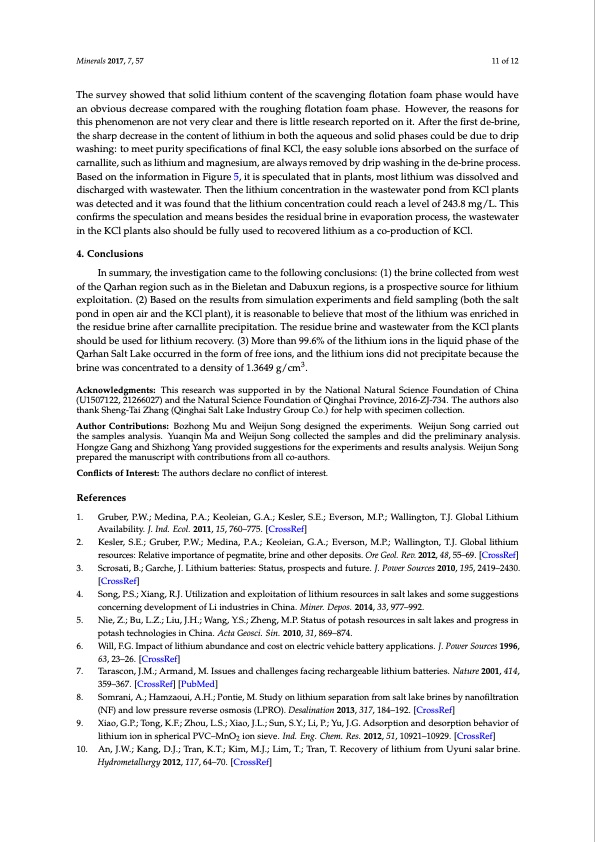
PDF Publication Title:
Text from PDF Page: 011
Minerals 2017, 7, 57 11 of 12 The survey showed that solid lithium content of the scavenging flotation foam phase would have an obvious decrease compared with the roughing flotation foam phase. However, the reasons for this phenomenon are not very clear and there is little research reported on it. After the first de-brine, the sharp decrease in the content of lithium in both the aqueous and solid phases could be due to drip washing: to meet purity specifications of final KCl, the easy soluble ions absorbed on the surface of carnallite, such as lithium and magnesium, are always removed by drip washing in the de-brine process. Based on the information in Figure 5, it is speculated that in plants, most lithium was dissolved and discharged with wastewater. Then the lithium concentration in the wastewater pond from KCl plants was detected and it was found that the lithium concentration could reach a level of 243.8 mg/L. This confirms the speculation and means besides the residual brine in evaporation process, the wastewater in the KCl plants also should be fully used to recovered lithium as a co-production of KCl. 4. Conclusions In summary, the investigation came to the following conclusions: (1) the brine collected from west of the Qarhan region such as in the Bieletan and Dabuxun regions, is a prospective source for lithium exploitation. (2) Based on the results from simulation experiments and field sampling (both the salt pond in open air and the KCl plant), it is reasonable to believe that most of the lithium was enriched in the residue brine after carnallite precipitation. The residue brine and wastewater from the KCl plants should be used for lithium recovery. (3) More than 99.6% of the lithium ions in the liquid phase of the Qarhan Salt Lake occurred in the form of free ions, and the lithium ions did not precipitate because the brine was concentrated to a density of 1.3649 g/cm3. Acknowledgments: This research was supported in by the National Natural Science Foundation of China (U1507122, 21266027) and the Natural Science Foundation of Qinghai Province, 2016-ZJ-734. The authors also thank Sheng-Tai Zhang (Qinghai Salt Lake Industry Group Co.) for help with specimen collection. Author Contributions: Bozhong Mu and Weijun Song designed the experiments. Weijun Song carried out the samples analysis. Yuanqin Ma and Weijun Song collected the samples and did the preliminary analysis. Hongze Gang and Shizhong Yang provided suggestions for the experiments and results analysis. Weijun Song prepared the manuscript with contributions from all co-authors. Conflicts of Interest: The authors declare no conflict of interest. References 1. Gruber, P.W.; Medina, P.A.; Keoleian, G.A.; Kesler, S.E.; Everson, M.P.; Wallington, T.J. Global Lithium Availability. J. Ind. Ecol. 2011, 15, 760–775. [CrossRef] 2. Kesler, S.E.; Gruber, P.W.; Medina, P.A.; Keoleian, G.A.; Everson, M.P.; Wallington, T.J. Global lithium resources: Relative importance of pegmatite, brine and other deposits. Ore Geol. Rev. 2012, 48, 55–69. [CrossRef] 3. Scrosati, B.; Garche, J. Lithium batteries: Status, prospects and future. J. Power Sources 2010, 195, 2419–2430. [CrossRef] 4. Song, P.S.; Xiang, R.J. Utilization and exploitation of lithium resources in salt lakes and some suggestions concerning development of Li industries in China. Miner. Depos. 2014, 33, 977–992. 5. Nie, Z.; Bu, L.Z.; Liu, J.H.; Wang, Y.S.; Zheng, M.P. Status of potash resources in salt lakes and progress in potash technologies in China. Acta Geosci. Sin. 2010, 31, 869–874. 6. Will, F.G. Impact of lithium abundance and cost on electric vehicle battery applications. J. Power Sources 1996, 63, 23–26. [CrossRef] 7. Tarascon, J.M.; Armand, M. Issues and challenges facing rechargeable lithium batteries. Nature 2001, 414, 359–367. [CrossRef] [PubMed] 8. Somrani, A.; Hamzaoui, A.H.; Pontie, M. Study on lithium separation from salt lake brines by nanofiltration (NF) and low pressure reverse osmosis (LPRO). Desalination 2013, 317, 184–192. [CrossRef] 9. Xiao, G.P.; Tong, K.F.; Zhou, L.S.; Xiao, J.L.; Sun, S.Y.; Li, P.; Yu, J.G. Adsorption and desorption behavior of lithium ion in spherical PVC–MnO2 ion sieve. Ind. Eng. Chem. Res. 2012, 51, 10921–10929. [CrossRef] 10. An, J.W.; Kang, D.J.; Tran, K.T.; Kim, M.J.; Lim, T.; Tran, T. Recovery of lithium from Uyuni salar brine. Hydrometallurgy 2012, 117, 64–70. [CrossRef]PDF Image | Lithium during Brine Evaporation and KCl Production Plants

PDF Search Title:
Lithium during Brine Evaporation and KCl Production PlantsOriginal File Name Searched:
minerals-07-00057-v2.pdfDIY PDF Search: Google It | Yahoo | Bing
Product and Development Focus for Infinity Turbine
ORC Waste Heat Turbine and ORC System Build Plans: All turbine plans are $10,000 each. This allows you to build a system and then consider licensing for production after you have completed and tested a unit.Redox Flow Battery Technology: With the advent of the new USA tax credits for producing and selling batteries ($35/kW) we are focussing on a simple flow battery using shipping containers as the modular electrolyte storage units with tax credits up to $140,000 per system. Our main focus is on the salt battery. This battery can be used for both thermal and electrical storage applications. We call it the Cogeneration Battery or Cogen Battery. One project is converting salt (brine) based water conditioners to simultaneously produce power. In addition, there are many opportunities to extract Lithium from brine (salt lakes, groundwater, and producer water).Salt water or brine are huge sources for lithium. Most of the worlds lithium is acquired from a brine source. It's even in seawater in a low concentration. Brine is also a byproduct of huge powerplants, which can now use that as an electrolyte and a huge flow battery (which allows storage at the source).We welcome any business and equipment inquiries, as well as licensing our turbines for manufacturing.| CONTACT TEL: 608-238-6001 Email: greg@infinityturbine.com | RSS | AMP |